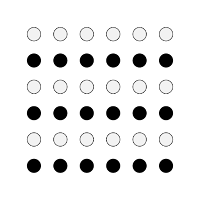[Tutorial] Introduction to design elements. Point
 |
| The Starry Night by Vincent van Gogh.Oil on canvas, 1889. Museum of Modern Art, NY |
A BRIEF INTRODUCTION TO GESTALT THEORY
As we spoke of deconstructing visual design into its basic elements to understand those, and of reconstructing a design from those elements to convey a specific message, this mechanism is originally inherent to the human mind.
The way we perceive the world through our eyes is complex and confusing; to process all that information the human brain tends to find the simplest solutions, and the sphere of psychology studying these mechanisms is known as gestalt psychology.
Draw a point on a blank piece of paper. It will instantly draw the attention of the viewer. Add a second point. The viewer's mind will connect these points and see a line. Add a third point, and they will see a triangle. You can continue this exercise and perceive other, more complex shapes.
The mechanisms compelling the mind to connect the parts into a whole are called grouping, or gestalt.
Gestalt is the foundation to building a composition from design elements. So let's understand the principles of how gestalt works:
- Proximity
 When the viewer looks at an assortment of elements, they perceive those in close proximity as a group.
When the viewer looks at an assortment of elements, they perceive those in close proximity as a group. - Similarity
 When a viewer looks at an assortment of elements, they group together those similar to each other. The elements can be similar in shape, size, color, or other qalities.
When a viewer looks at an assortment of elements, they group together those similar to each other. The elements can be similar in shape, size, color, or other qalities. - Closure

The viewer perceives shapes, letters, pictures, etc. as being whole even when they are not complete. When elements of the whole are missing, the brain fills the gaps, as long as there's enough detail for it to recognize the shape - Symmetry

The viewer tends to perceive objects as symmetrical and forming around a central point. Dividing an object into symmetrical parts is perceptually pleasing to the viewer. Thus, the mind tends to connect two unconnected symmetrical elements into a single symmetrical whole. - Common fate
 Common fate means the viewer perceives elements to have trends in motion, which indicate the path the element is on. Objects with trends that hint at a similar path are perceived as moving together. Take a look at the Van Gogh painting at the top of the article. Pay attention to how your mind traces movement paths and groups brush strokes following a similar path.
Common fate means the viewer perceives elements to have trends in motion, which indicate the path the element is on. Objects with trends that hint at a similar path are perceived as moving together. Take a look at the Van Gogh painting at the top of the article. Pay attention to how your mind traces movement paths and groups brush strokes following a similar path. - Continuity
 Continuity means the viewer tends to connect two elements together, if they are aligned in a shape the viewer recognizes. If the viewer perceives two shapes, they group elements aligned in these shapes separately as two distinct entities. Elements with sharp directional changes are less likely to be grouped together.
Continuity means the viewer tends to connect two elements together, if they are aligned in a shape the viewer recognizes. If the viewer perceives two shapes, they group elements aligned in these shapes separately as two distinct entities. Elements with sharp directional changes are less likely to be grouped together.
Now that we have an understanding of how human perception groups elements together, we can move on to the subject of this article.
A point should be small and simple enough to be perceived as a single element. A point has qualities such as its size, shape, value, regularity or irregularity, etc.
A point can be a separate element of design or used in a group. We already studied how the mind groups elements together - all those principles apply here.
There is a separate genre in digital art known as pixel art. In pixel art, the square pixels are used as points to emulate the low-resolution graphics of days past. Ever thought of deconstructing Nyan Cat from the design standpoint?
Groupings of points can be used to form shapes and patterns or to delineate (describe) space: smaller or closer points mean further, larger or further points - closer.
A POINT (ALSO KNOWN AS A MARK)
The smallest and most basic element in design is a point, also known as a mark. The dots used by pointillist artists such as Georges Seurat are a perfect example of a point.
 |
| Part of The Eiffel Tower by Georges Seurat. Oil on canvas, 1889. California Palace of the Legion of Honor, SF |
A point should be small and simple enough to be perceived as a single element. A point has qualities such as its size, shape, value, regularity or irregularity, etc.
A point can be a separate element of design or used in a group. We already studied how the mind groups elements together - all those principles apply here.
There is a separate genre in digital art known as pixel art. In pixel art, the square pixels are used as points to emulate the low-resolution graphics of days past. Ever thought of deconstructing Nyan Cat from the design standpoint?
Groupings of points can be used to form shapes and patterns or to delineate (describe) space: smaller or closer points mean further, larger or further points - closer.



Comments
Post a Comment